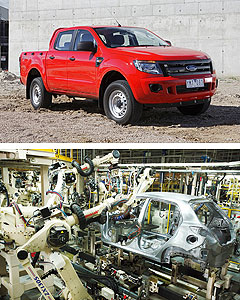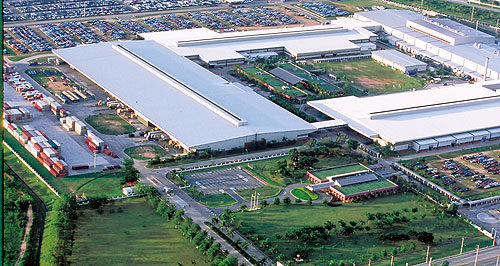News - Mazda - BT-50Mazda-Ford expands Thai ute productionOn line: Mazda and Ford will benefit from a 17 per cent increase in production capacity for its one-tonne utes in Thailand. Extra investment to meet global demand for Aussie-developed Ranger and BT-50 utes1 May 2012 MAZDA and Ford are expanding capacity at a joint-venture production facility in Thailand to meet global demand for their Australian-developed new-generation Mazda BT-50 and Ford Ranger pick-ups. Production capacity will grow by 20,000 units a year to 140,000 utes from next month as a result of a joint investment of $US27 million ($A26 million) by Mazda Motor Corporation and Ford Motor Company. Ranger and BT-50 utes sold in Australia are produced at the AutoAlliance (Thailand) plant, which has been operating since 1998. The AAT plant also produces the Ford Everest SUV, and passenger vehicles such as the Ford Fiesta, Mazda2 and Mazda3, for both domestic consumption and export. Australian-market Fiestas are built there, as well as Ranger and BT-50. However, Mazda Australia public relations manager Steve Maciver said the extra capacity was for utes only and that Australian-market Mazda2 vehicles will continue to be produced in Japan – along with our Mazda3. Mazda2 production moved to Thailand in mid-2010 to take advantage of a Free Trade Agreement with Australia, but returned to Japan only a year later when catastrophic floods in October brought production at the AAT plant to a halt.  From top: The Ford Ranger and the AutoAlliance Thailand plant. From top: The Ford Ranger and the AutoAlliance Thailand plant.Non-ute production at the Thai facility amounts to 100,000 units a year while total production is boosted by 55,000 export utes in CKD (completely knocked down) form, taking AAT’s total output to 295,000. New investment in the plant will include facility upgrades such as additional robotic equipment and tooling to help increase line speed and output. Mazda and Ford’s total joint investment in AAT now amounts to almost $US2 billion ($A1.92 billion). Only two years ago the two partners invested $US350 million ($A336 million) to upgrade facilities in preparation for production of the BT-50 and Ranger utes that were designed and developed at Ford Australia in Broadmeadows. Ford ASEAN president Peter Fleet said the new investment reinforced Ford Motor Company’s long-term commitment to Thailand as a global production and export hub, and allow the company to meet “extraordinary demand” Ranger. Mazda Motor Corporation senior managing executive director Yuji Nakamine said the additional investment was “part of the strategic business partnership between Ford and Mazda” and would help meet demand for the BT-50. Despite posting a $1.3 billion loss last year and being forced to sell some assets, Mazda has also committed to building a new 50/50 joint-venture plant in Russia with OJSC Sollers, a Moscow-based automotive company with links to Isuzu, SsangYong and Fiat, and headed by former GM vice-president David Herman. The new plant will produce the new Mazda CX-5, the next-generation Mazda6 and a Sollers-owned brand vehicle, but only for the fast-growing Russian market, which last year grew 40 per cent to 2.65 million units – of which Mazda only accounted for about 40,000. Production at the new Vladivostok plant will initially be set at 50,000 a year, with the aim of rising to 70,000.  Read more30th of April 2012  Mazda posts huge loss$1.3 billion loss for Mazda, but Honda remains in profit and projects big increase20th of February 2012  Ford vows to stage comebackHorror start to 2012 caused by temporary supply problems, claims Ford1st of November 2011  Thai floods sink utesDevastating floods to impact Oz ute supplies as most Thai factories remain closed |
Click to shareMazda articlesResearch Mazda BT-50 pricing
Motor industry news |
















Facebook Twitter Instagram